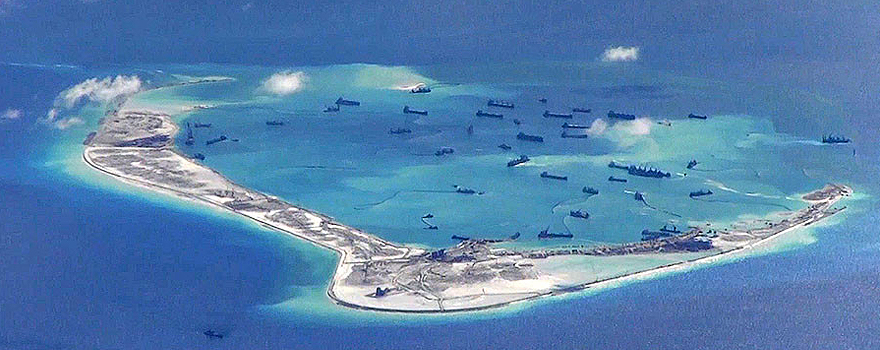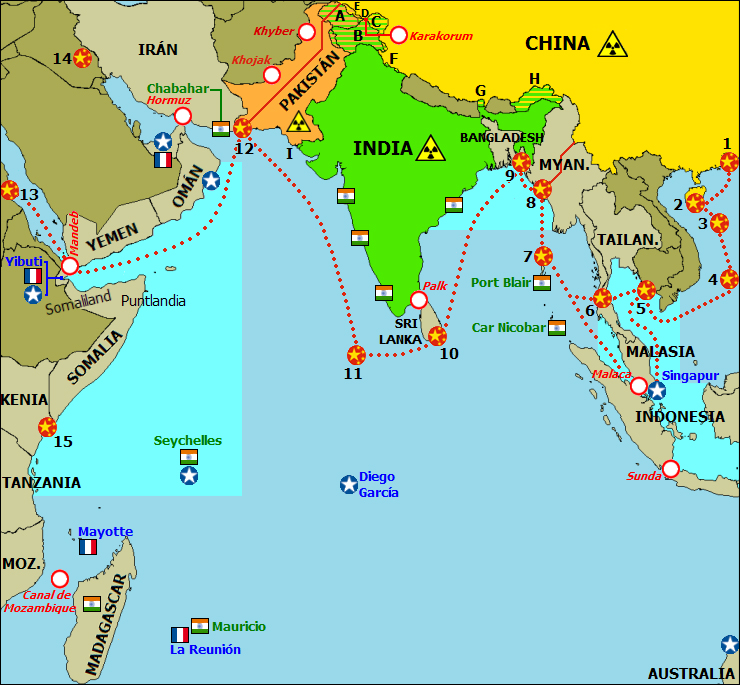Ruta de navegación
Blogs
Entries with label china-indian relationship .
skill of the two powers to have instructions in the Indian Ocean and to be active in strategic neighboring countries.
Rumors of possible future Chinese military use of area in Gwadar (Pakistan), where Beijing already operates a port, have added a great deal of attention in the last year to the rivalry between China and India to secure access to points in the region that will allow them to control the Indian Ocean. India regards this ocean as its own, while for China it is vital to ensure the security of its energy supplies from the Middle East.

▲ China's work to transform Subi Reef in the Spratly Islands into an island in 2015 [US Navy].
article / Jimena Puga
The two major Asia-Pacific powers, China and India, are vying for regional supremacy in the Indian Ocean by establishing military instructions and economic agreements with bordering countries such as Pakistan. The Indian Ocean, which borders Africa, the Middle East, Asia and Australia, is home to one of the most crucial and strategic points for international trade. Nearly 40% of the oil extracted from the sea is produced in the Indian Ocean, which also has rich mineral and fishing deposits.
Five years ago China began its major territorial reclamation in the South China Sea, and the country has established a territorial status quo in its favor without receiving any international impediments, in order to counter the US military presence in the region, established during the Cold War, and which controls the South China Sea and all goods coming from Africa, the Middle East and the Strait of Malacca. This territorial expansion of the Middle Empire began in December 2013; since then China has built more than average dozen more artificial islands, located in a strategic location through which a third of global maritime trade passes, and has deployed military assets on them.
However, the creation of these islands has caused great damage to the region's marine ecosystem. The coral reefs that China has destroyed in order to use them as a base for the establishment of its islands provided food and shelter for numerous marine species, as well as supplies for Asia's most important fishing companies. However, thanks to this territorial expansion China is in a better position not only for maritime and air control of the area but also to continue to advance its strategy of power projection in the Indian Ocean and part of the Pacific to satisfy its plans for power and supremacy in the region.
Neocolonization
In early 2018, some reports suggested that China plans to set up a naval base next to the port it is developing in Gwadar, in Pakistan, although Pakistani authorities deny that Beijing has requested that the facilities be put to that use. In any case, the docking of military vessels at area in Gwadar would connect that point with the country's recent military and naval base built in Djibouti - the first China has abroad - as part of a growing network own of instructions air and naval along the Indian Ocean.
India, the greatest power among regional countries, is responding to Chinese expansion with unexpected strength. Delhi aspires to control the most strategic maritime trade points in the Indian Ocean including the Straits of Malacca and Hormuz and the Mozambique Channel. In addition, India is gaining access to the instructions of its foreign allies in the region. In 2017 it signed a logisticsagreement with the US that would mean free access to US military installations across the region (agreement which perhaps has something to do with the US desire to create an alternative to the Silk Belt and Road Initiative and curb the rapid growth of the Asian superpower).
In January 2018, India also announced the agreement logistical exchange with France involving free access to French military facilities in Djibouti, namely in the Red Sea and on the island of meeting, south of the Indian Ocean (perhaps to counter Sino-European agreements). Finally, India is also building strategic relations and infrastructure near the Persian Gulf. And after years of negotiations, Delhi has managed to formalize a agreement with Iran to modernize and expand the port of Chabahar, near the Strait of Hormuz. While it is true that the vast majority of agreements are commercial in nature, they have enough potential to increase India's access and influence in Central Asia.
In response to Beijing's military base in Djibouti, New Delhi has begun seeking access to new facilities in Seychelles, Oman and Singapore. From Tanzania to Sri Lanka the two Asian powers are attempting to increase their military and economic presence in countries along the Indian Ocean in their mission statement for regional supremacy. Finally, it is possible that India's 2017 request for drones from the US was aimed at goal monitoring Chinese activity in the ocean.
"My Chinese colleagues have explicitly told me that if the U.S. continues to fly over and navigate in what they self-described as 'their waters,' China will shoot down the corresponding intruder," said Matthew Kroenig, a CIA and Pentagon analyst. "Maybe it's just a bluff, but if China were to shoot down an American plane, it would be the perfect scenario for a U.S. military buildup. It's hard to see President Trump or any other American leader turn his back on this issue."
|
PEARL NECKLACE OF CHINA. 1-Hong Kong; 2-Hainan; 3-Paracel Islands (disputed); 4-Spratly Islands (disputed), 5- Sihanoukville and Raum (Cambodia), ports; 6-Itsmo de Kra (Thailand), infrastructure; 7-Cocos Islands (Myanmar), antennas; 8-Sittwe (Myanmar), port; 9-Chittagong (Bangladesh), port; 10-Hambantota (Sri Lanka), port; 11-Marao (Maldives), offshore exploration; 12-Gwadar (Pakistan), port; 13-Port Sudan; 14-Al Ahdab (Iraq), oil exploitation; 15-Lamu (Kenya), port. Chart from 2012; missing to note China's first overseas military base, in Djibouti, inaugurated in 2017 [Edgar Fabiano]. |
Globalization
The moves by both powers stem from the fear that the other countries will join in coalition with their opponent in the future, but they also do not want to completely abandon the expansion of economic relations with each other by altering the regional order too drastically.
This power of the weak has limitations, but it has so far worked to the benefit of both India and China. Due to globalization, particularly in the economic sphere, weaker states have adopted asymmetric strategies to extract resources from their neighboring superpowers that aspire to be leaders on the international stage. Often, these border countries had to choose a superpower to obtain resources, as was the case during the Cold War. The difference in this era of globalization is that these states can extract concessions and resources from both Beijing and Delhi without formally aligning themselves with one of them, as is the case, for example, with Vietnam. The absence of a bloc rivalry, as was the case during the Cold War, and the high levels of economic interdependence between India and China make it easier for many of the smaller states to avoid signing an alliance with one of these leaders.
India's subtle strategy involves developing entente with Japan and the member countries of the association of Southeast Asian Nations (ASEAN), as well as with the United States. Specifically, the quadrilateral negotiations initiated between India, Japan, the US and Australia are another stabilizing mechanism vis-à-vis China.
However, the strategies of the smaller states in South Asia have limitations. Although China is offering greater economic attendance , these countries, except Pakistan, are unlikely to form military alliances with China because if they do, it would provoke a negative response from India, the dominant power in the region, and the United States, the international superpower that still has a strong naval presence in the Indian Ocean. We are witnessing a new dynamic of diplomatic relations in the Asia-Pacific region.
This new trend of rapprochement with smaller countries translates into an inclination to use economic appeal to persuade neighbors rather than military coercion. How long this trend will continue remains to be seen. India's new strategies with other international powers may be the key to complicating the freedom of action and decision that China is having in the military realm, especially in this time of peace. What is clear is that China's aspiration for supremacy is visible by all countries that are part of the Asia-Pacific region and will not be as easy to establish as the Empire at the Center thought.

